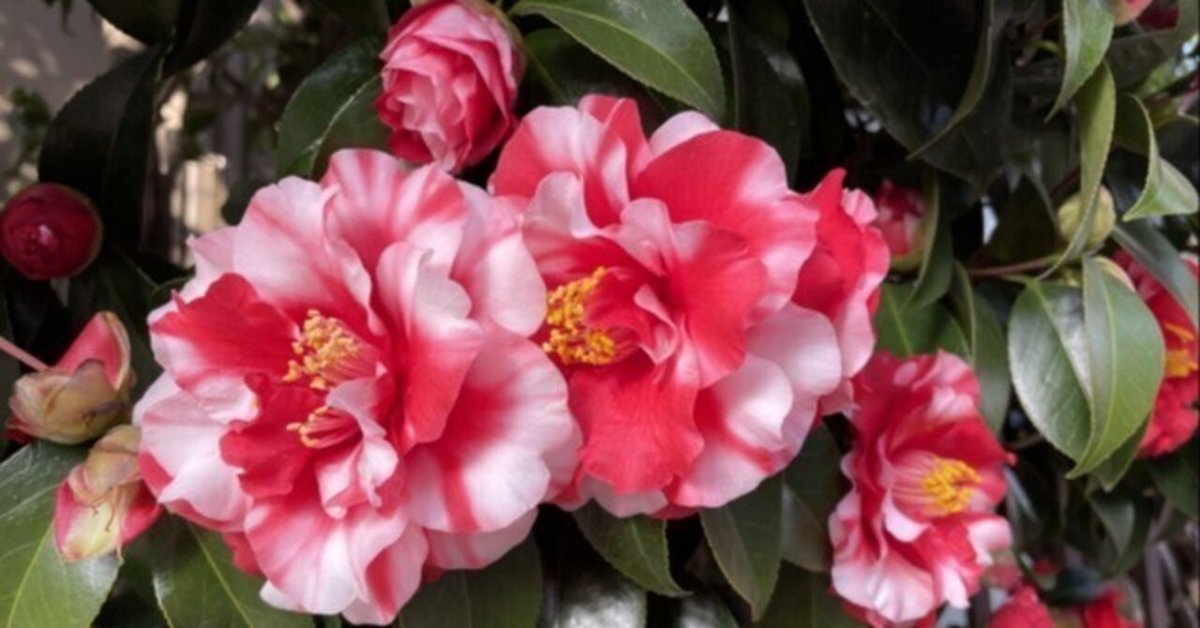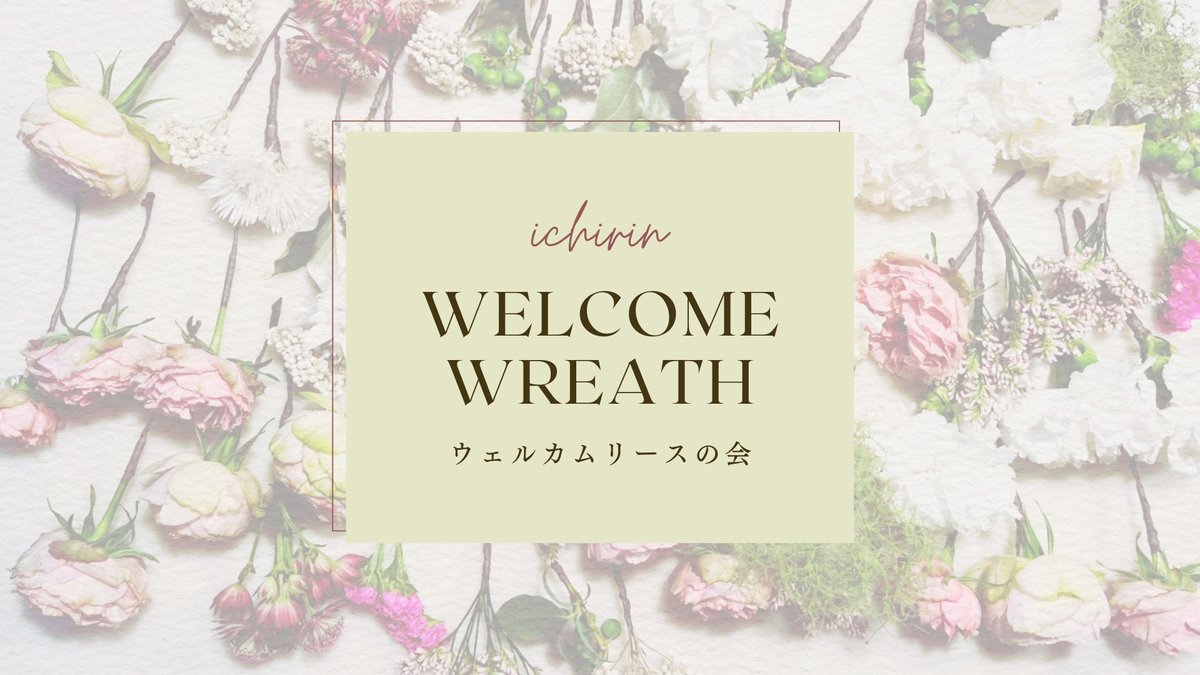
ジャパニーズビューティー・早咲き椿
近所の神社には、本殿の横から通りに出るための階段が20段ほどあります。その階段の脇に、可愛らしい花が咲いていました。
濃いピンクの斑入りの、ヒラヒラしたツバキ(椿)の花です。
椿というと冬のイメージですが、あれ?もう咲いてる、、、!?
実は、椿は9月頃から咲き始める「早咲き」の種類があります。
私が見かけたのも、早咲きの品種で、決して季節外れに間違って咲いてしまったものではありません。
どんな種類の椿なんだろう・・・と気になって、帰宅後さっそく「早咲きツバキ」で検索してみました。
検索画像とぴったりしたものは無かったのですが、おそらく「大神楽(だいかぐら)」と呼ばれる種類の椿かと思われます。

椿は日本原産の植物。5〜10メートルくらいが標準的な高さだそうですが、15メートルほどになるものも。ただ、成長が遅いのが特徴。ゆっくり大きくなり、そして長寿。英語名は、Camellia Japonica。学名と同じ英語名は珍しいそう。日本オリジナル!っていう感じがしていいですね。
以前、桜の咲くころに見たインパクト大の肥後椿について書いたことがありますが、あれは4月頭のこと。その時期に咲く椿もあれば、秋から咲く種類もあるのだから、一年の3分の2は様々な種類の椿が見られるということ。流石はツバキ原産国!
椿は花が終わる時に、ガクを残してボタっと花ごと落ちます。その姿を首が落ちることに似ているとして武士が忌み嫌ったと言いますが、それは幕末以降の話らしいですね。もともとは縁起の良い木として古くから日本人に愛されてきた植物ですし、江戸時代には大ブームが来て、こぞって品種改良が進められました。寛永7年(1630年)には伝狩野山楽が描いた『百椿図』(根津美術館所蔵)が、さらに寛永11には烏丸光広によって『椿花図譜』が著され、そこには619種のツバキが紹介されています。
興味を引かれたのが、「年を経たツバキは化けるという言い伝えが日本各地に残る。新潟の伝説では、荒れ寺に現れる化け物の正体が椿の木槌であったり、島根の伝説では、牛鬼の正体が椿の古根だったという話がある。」というくだり。(ウィキペディアより)
これって、面白い!他にもいろいろな言い伝えが日本各地に伝承されている可能性も大ですよ!もしも自分が大学生だったら、こんなテーマを掘り下げて卒論など書いてみたかったな、と思いました。
さて、椿の花言葉をお伝えします。
「控えめな優しさ」
種類によっては、びっくりするくらい華やかでゴージャスなタイプのものもあるけれど、確かによく見かけるヤブツバキは周りの風景(それが野山であっても住宅街であっても)に溶け込んで控えめに咲いています。長い期間私たちの目を楽しませてくれる椿。みなさんも、ぜひどんな種類の椿があるか、見てみませんか?メルマガの最後にリンクをご紹介しますね。
ちなみに、私の好みの子は可愛らしいポピーのような「石鎚」と、まるで白薔薇な「Alba Plena」。そのほかにも黄色や黒い椿も!!
リンク↓
https://www.flower-db.com/ja/features/camellia
【編集後記🥀】
いつも滋賀県からオンラインでいけばな教室にご参加くださっている生徒さんが、東京にいらして対面でレッスンを受講!お教室の皆さんとお喋りしながらの楽しいお稽古に、皆の笑顔が弾けていました。お花で繋がる幸せ🌸。最高の時間でした!
There’s a set of about 20 steps at my neighborhood shrine leading from the main hall to the street. Beside those steps, I noticed a charming flower blooming.
【Ichirin’s Ikebana 🌸 Early-Blooming Camellia】
The flower was a vibrant pink camellia with delicate, ruffled petals. Camellias are typically associated with winter, so I thought, “Already blooming?!”
In fact, some varieties of camellias start flowering as early as September. The one I saw was an early-blooming type, blooming right on schedule and not by mistake.
Curious about the variety, I searched “early-blooming camellia” as soon as I got home.
While I couldn’t find an exact match, I think it might be a type known as “Daikagura.”

Camellias are native to Japan, typically growing 5 to 10 meters tall, though some reach around 15 meters. Known for slow growth, camellias are also long-lived. Interestingly, its English name is the same as its scientific name: Camellia Japonica. It’s rare to see an English name identical to the scientific one—adding to its Japanese charm!
Camellias are unique in that when they finish blooming, the entire flower drops, leaving behind the calyx. This characteristic made samurai view them with a bit of unease, as it symbolized a falling head. But this notion only started in later years; camellias were long considered a lucky plant. By the Edo period, a camellia trend took off, with people avidly developing new varieties. In 1630, for example, an illustrated scroll titled “One Hundred Camellias” was created by the artist Kanō Sanraku (held at the Nezu Museum). Just a few years later, in 1634, Mitsuhiro Karasumaru cataloged 619 types in his work “Camellia Flower Pictorial.”
I found it fascinating that various regions in Japan have folktales of camellias taking on supernatural forms with age. For example, in Niigata, there’s a tale of a camellia wood mallet transforming into a ghost haunting an abandoned temple. In Shimane, a similar legend tells of an ancient camellia root turning into a creature called the Ushi-Oni. Imagine the possibilities of more such tales scattered across Japan! If I were still in school, I’d be tempted to write a thesis on this topic.
To close, here’s the flower language of the camellia: “modest kindness.”
While some camellias are unexpectedly glamorous, many, like the common Yabutsubaki, bloom quietly and blend in harmoniously with their surroundings, whether in forests or urban neighborhoods.
Camellias’ long-lasting beauty offers us endless moments of enjoyment, why not explore the different types of camellias too? I’ll leave a link at the end for more information!
Personally, I’m fond of the charming “Ishizuchi,” which looks like a petite poppy, and the white-rose-like “Alba Plena.” There are even yellow and black camellias!
Link: https://www.flower-db.com/ja/features/camellia
[Editorial Note 🥀]
One of our students, who usually joins our ikebana classes online from Shiga Prefecture, recently visited Tokyo and joined us in person! The session was lively, filled with conversations and laughter among the students. Connecting through flowers is such a joy—it was an unforgettable time!
🌿🌿🌿🌿🌿🌿🌿🌿🌿🌿🌿🌿🌿🌿🌿🌿🌿🌿🌿🌿🌿🌿🌿🌿🌿🌿🌿🌿🌿🌿🌿🌿🌿🌿
ichirinフラワーアレンジメントスクール・龍生派一綸いけばな教室 受講者募集中!
いずれもオンラインレッスン・対面レッスンがあります。
フラワーアレンジメント教室は、「ウェルカムリースの会」として、リニューアルしました!季節のお花を楽しむ会なので、興味のある回に単発で参加も可能です。

いけばな教室はコース仕立てなので、効率的・計画的に実力をつけていけます。龍生派のお免状も取得できるいけばな専門のコースです。(対面6,000円、オンライン9,000円/回)また、自分のペースでのんびり学びたいという方ももちろんOK!(月に1回〜)。お気軽に体験レッスンもできます。

一綸いけばな教室のウェブサイトは以下のリンクからご覧いただけます。
https://ichirin-ikebana.com/
🌿🌿🌿🌿🌿🌿🌿🌿🌿🌿🌿🌿🌿🌿🌿🌿🌿🌿🌿🌿🌿🌿🌿🌿🌿🌿🌿🌿🌿🌿🌿🌿🌿🌿
ichirin代表大澤尚子の活動情報はこちら。
・ichirinウェルカムリースの会
・ネットショップ:ichirin’s STORE
・Instagram(アレンジメント、リース、スワッグ):ichirin (@hanasakka.ichirin)
・Instagram(いけばな):大澤 尚子 (@ichirin_naoko)

この記事が気に入ったらサポートをしてみませんか?
